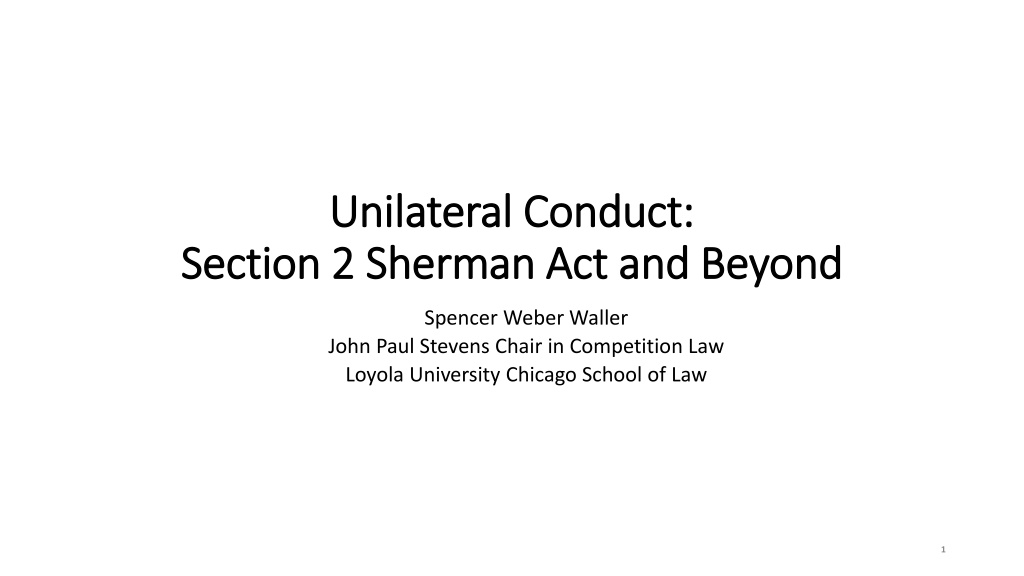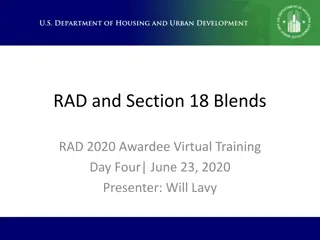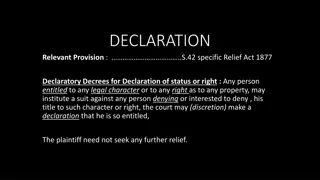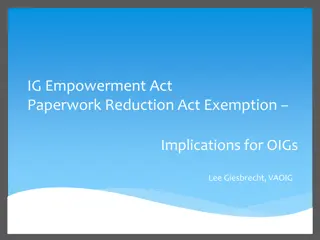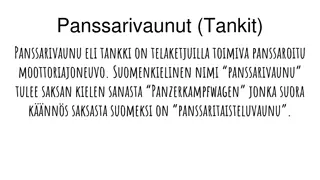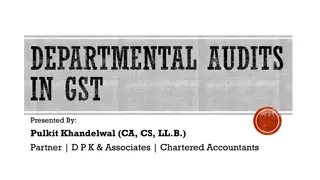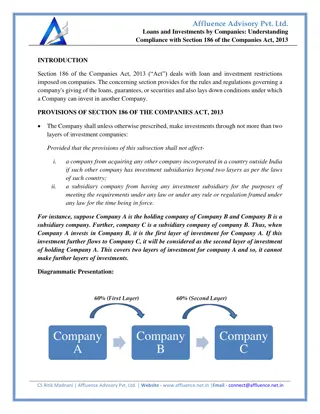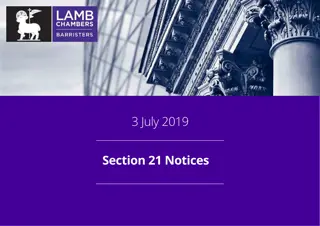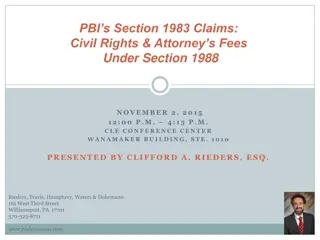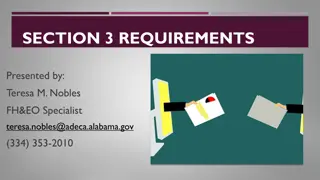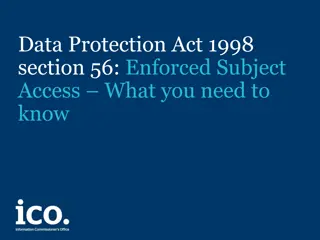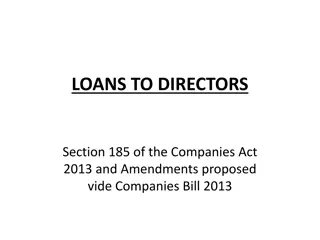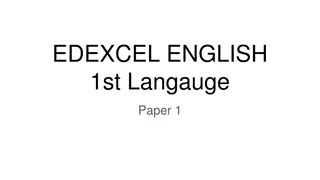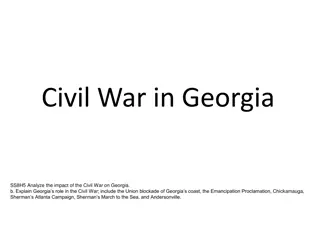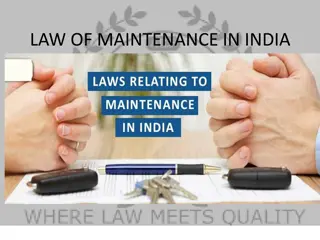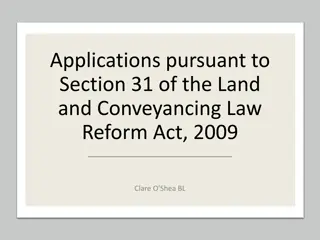Understanding Section 2 of the Sherman Act
Section 2 of the Sherman Act addresses unilateral conduct related to monopolization and anti-competitive behavior. It focuses on the possession or acquisition of monopoly power, predatory conduct, and the intent to monopolize. The key principle under US law governing single firm conduct is the proof of monopoly power or dangerous probability. Exclusionary conduct to obtain or maintain monopoly power is deemed unlawful, highlighting the importance of preventing firms with market power from excluding competition.
Download Presentation

Please find below an Image/Link to download the presentation.
The content on the website is provided AS IS for your information and personal use only. It may not be sold, licensed, or shared on other websites without obtaining consent from the author. Download presentation by click this link. If you encounter any issues during the download, it is possible that the publisher has removed the file from their server.
E N D
Presentation Transcript
Unilateral Conduct: Unilateral Conduct: Section 2 Sherman Act and Beyond Section 2 Sherman Act and Beyond Spencer Weber Waller John Paul Stevens Chair in Competition Law Loyola University Chicago School of Law 1
Sherman Act Section 2 Sherman Act Section 2 Every person who shall monopolize, or attempt to monopolize, or combine or conspire with any other person or persons, to monopolize any part of the trade or commerce among the several States, or with foreign nations, shall be deemed guilty of a felony, and, on conviction thereof, shall be punished by fine not exceeding $100,000,000 if a corporation, or, if any other person, $1,000,000, or by imprisonment not exceeding 10 years, or by both said punishments, in the discretion of the court. No criminal enforcement since early 1970s 2
Key Principle of US Law Governing Single Firm Conduct Key Principle of US Law Governing Single Firm Conduct Proof of Monopoly Power or Dangerous Probability Required but Not Enough Market power: the ability to raises prices above those that would be charged in a competitive market. Monopoly power: the power to control prices or exclude competition ("durable" market power). Only Exclusionary Conduct to Obtain or Maintain Monopoly Power is Unlawful Possession or exercise of monopoly power, or conduct to maintain monopoly power that is not anticompetitive, is not unlawful. Purely abusive conduct (excessive pricing) not a violation Textual Reason High prices invite entry rather than exclude competition Monopoly power also may be incentive for entry and innovation (Trinko) But see Apple Inc. v. Pepper (Exclusionary conduct as basis for violation, monopoly overcharge as measure of damages) Concern is Conduct by a Firm with Market or Monopoly Power to Exclude, Deter Entry, or Keep Actual or Potential Rivals from Becoming Viable Competitors 3
Elements of Section 2 Offense Based on Unilateral Conduct Elements of Section 2 Offense Based on Unilateral Conduct Monopolization Possession of monopoly power in the relevant market Willful acquisition or maintenance of that power Attempted monopolization Predatory or anticompetitive conduct Specific intent to monopolize Dangerous probability of achieving monopoly power See Swift and Spectrum Sportsv. McQuillan 4
Non Non- -Unilateral Section 2 Offenses Unilateral Section 2 Offenses Monopolization by acquiring control of competitors Typically addressed under Section 7 of the Clayton Act. Monopolization through agreements with competitors (market division etc.) Typically addressed under Section 1 of the Sherman Act. Conspiracy to monopolize Requires agreement, overt act, and specific intent to monopolize. Question of whether dangerous probability of success is required after Spectrum Sportsv. McQuillan Typically addressed under Section 1, Sherman Act 5
Proof Proof of Monopoly Power/Dangerous Probability of Monopoly Power/Dangerous Probability Direct proof of control over prices or the ability to exclude competitors Rarely available Proof of substantial share of the relevant market Alcoa s 30/60/90 Rules of Thumb Shares above 50% generally enough for attempted monopolization Market Definition and Market Share Only the Beginning Inference of market power based on share of well defined market can be overcome based on low barriers to entry, recent successful entry, or other evidence of healthy market performance 6
Proof of Exclusionary Conduct Proof of Exclusionary Conduct Obtaining monopoly power by superior products, innovation, business acumen, accident, or dumb luck is legal Harm to the competitive process required, not just harm to a competitor No single standard for determining whether conduct is exclusionary Conduct that is not competition on the merits, not honestly industrious, or lacking legitimate business justification More limited approach relies on no economic sense or profit sacrifice (not clear whether necessary or merely sufficient) Makan Delrahim hinted that DOJ would apply no economic sense test in upcoming tech investigations in 2019 Tel Aviv speech, https://www.justice.gov/opa/speech/assistant- attorney-general-makan-delrahim-delivers- remarks-antitrust-new-frontiers 7
Microsoft Standard Broadly Consistent with Rule of Reason under Section One The plaintiff, on whom the burden of proof of course rests, must demonstrate that the monopolist's conduct has the requisite anticompetitive effect. If a plaintiff successfully establishes a prima facie case under 2 by demonstrating anticompetitive effect, then the monopolist may proffer a procompetitive justification for its conduct. If the monopolist's procompetitive justification stands unrebutted, then the plaintiff must demonstrate that the anticompetitive harm of the conduct outweighs the procompetitive benefit. Evidence of the intent behind the conduct of a monopolist is relevant only to the extent it helps us understand the likely effect of the monopolist's conduct. United States v. Microsoft Corp., 253 F. 3d 34, 58 (D.C. Cir. 2001). 8
Refusals to Deal Refusals to Deal Concern is refusals to deal with rivals, not refusals to deal with customers. Cases recognize monopolists sometimes have a duty to deal. Lorrain Journal: The one Section 2 case beloved by all commentators Aspen Skiing: right to refuse to deal is not unqualified Essential facilities doctrine recognized in lower courts, but not applied by name by the Supreme Court Applies where a monopolist denies access to a truly essential facility that cannot practically be duplicated and where it is feasible to provide access (MCI v. ATT) Not applicable if access provided by comprehensive regulatory regime (Trinko) Supreme Court increasingly hostile to unilateral refusal to deal claims Trinko: Aspen is at or near the outer boundary of Section 2 liability. Post-Trinko cases find no duty to deal where there was no voluntary prior course of dealing or where there was a legitimate business justification. 9
Exclusive Dealing Exclusive Dealing Exclusive dealing, even by a monopolist, is sometimes procompetitive. Tampa Electric: Liability under Section 1 where substantial share usually 30%-40% or more is foreclosed by the exclusive deal. Greater concern exclusive dealing by monopolists. Liability upheld under Section 2 (but not Section 1) where exclusive dealing prevented effective market access by actual and nascent competitors. (Microsoft) De facto exclusive dealing (e.g. through loyalty discounts) usually treated like exclusive dealing. 10
Predatory Pricing Predatory Pricing Judicial hostility to predatory pricing claims: Matsushita: Rarely tried, and even more rarely successful and claims chill the very conduct the antitrust laws are designed to protect Brooke Group test: Pricing below an appropriate measure of cost (usually AVC) Dangerous probability of recouping investment in below-cost prices. Same principles apply to predatory bidding (Weyerhaeuser)and price squeeze claims (linkLine Communications) Since Brooke Group no successful predatory pricing verdict upheld 11
Bundled Pricing Bundled Pricing Discounts/low prices usually benefit consumers. But some bundled pricing schemes can excluded even equally efficient rvials with more limited product lines. (LePage) Courts have used tying, exclusive dealing, and predatory pricing analogies. Discount attribution test from Cascade Health Solutions v. PeaceHealth Apply total discount for taking the bundle to element of the bundle in which competition is allegedly foreclosed, and ask whether an equally efficient competitor could profitably sell at that price. FTC applied the same standard in its consent decree in Intel. 12
Antitrust and Intellectual Property Antitrust and Intellectual Property Monopolization Through Assertion of Invalid or Unenforceable IP rights Walker Process (enforcing patents obtained through fraud on the PTO) and Handgards (assertion of IP rights that are unenforceable). Monopolization Through Refusals to License IP Ninth Circuit in Kodak: IP refusals unlawful where refusal to license is pretextual. Federal Circuit (Xerox/In re ISO) & Seventh Circuit (Schor v. Abbott Labs): Refusal to license lawfully- acquired IP is always lawful Monopolization Through Misuse of Standard Setting Conduct Rambus: Liability for failure to disclose patents to SSO turns on whether a different standard would have been adopted with disclosure. FTC has applied a different standard under Section 5: E.g. Robert Bosch GmbH Monopolization Through Licensing of Standard Essential Patents FTC v. Quallcomm No License no Chip Per Processor Royalties Refusal to Sell to Rivals Current Split Between FTC and DOJ 13
Liability for Unilateral Conduct Significantly Broader Outside the United States Most Countries Apply Abuse of Dominance Standard EU and Other Jurisdictions Prohibit any Abuse of Dominance including but not limited to: a) directly or indirectly imposing unfair purchase or selling prices or other unfair trading conditions; (b) limiting production, markets or technical development to the prejudice of consumers; (c) applying dissimilar conditions to equivalent transactions with other trading parties, thereby placing them at a competitive disadvantage; (d) making the conclusion of contracts subject to acceptance by the other parties of supplementary obligations which, by their nature or according to commercial usage, have no connection with the subject of such contracts. TFEU, Article 102 Some Jurisdictions have By Object as well as By Effect Standard for Abuse 14
Abuse of Dominance Includes Both Abusive and Exclusionary Conduct Dominance Can be Found With Market Shares of 30-40%, Usually Presumed over 50% Prohibits Abusive Conduct Including Excessive Pricing and Price Discrimination by Dominant Firms No Recoupment Typically Required for Predatory Pricing Refusals to Supply and Essential Facilities Doctrine Robustly Applied Tying, Bundling, Price Squeezes and Loyalty Discounts Aggressively Challenged Abuse of IP also Challenged Remedies Include Fines up to 10% of Global Annual Turnover, Behavioral Remedies, and at Least one Structural Separation of Electrical Grid Many of the specific EU challenges to tech giants such as Microsoft, Facebook, Google, Intel would not necessarily have been violations of the narrower Section 2 EU Article 102 model for many other jurisdictions 15
For More Information see Chapter 2, Kessler & Waller, International Trade and U.S. Antitrust Law (2d ed. 2019) Volume II-III, Areeda and Hovenkamp, Antitrust Law (4th ed. 2013) Antitrust Law Developments 223-348 (8th ed. 2017) Chapter 2, Holmes & Mangiaracina, Antitrust Law Handbook (2018-19 ed.) Gavil & First, The Microsoft Cases: Competition Policy for the Twenty-First Century (2014) Or Contact Spencer Weber Waller John Paul Stevens Chair in Competition Law Loyola University Chicago School of Law swalle1@luc.edu 312-915-7137 https://papers.ssrn.com/sol3/cf_dev/AbsB yAuth.cfm?per_id=145112 16
